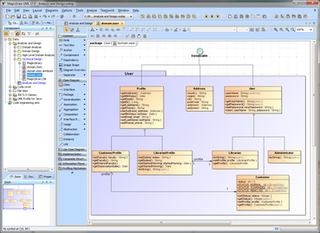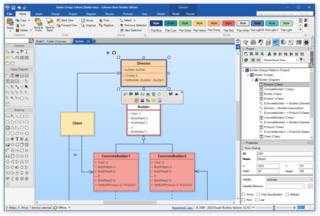
The Object Management Group (OMG) is a computer industry standards consortium. OMG Task Forces develop enterprise integration standards for a range of technologies.

The unified modeling language (UML) is a general-purpose modeling language that is intended to provide a standard way to visualize the design of a system.
The Web Services Business Process Execution Language (WS-BPEL), commonly known as BPEL, is an OASIS standard executable language for specifying actions within business processes with web services. Processes in BPEL export and import information by using web service interfaces exclusively.

Business Process Model and Notation (BPMN) is a graphical representation for specifying business processes in a business process model.

Unicom System Architect is an enterprise architecture tool that is used by the business and technology departments of corporations and government agencies to model their business operations and the systems, applications, and databases that support them. System Architect is used to build architectures using various frameworks including TOGAF, ArchiMate, DoDAF, MODAF, NAF and standard method notations such as sysML, UML, BPMN, and relational data modeling. System Architect is developed by UNICOM Systems, a division of UNICOM Global, a United States-based company.
Model-driven engineering (MDE) is a software development methodology that focuses on creating and exploiting domain models, which are conceptual models of all the topics related to a specific problem. Hence, it highlights and aims at abstract representations of the knowledge and activities that govern a particular application domain, rather than the computing concepts.

MagicDraw is a proprietary visual UML, SysML, BPMN, and UPDM modeling tool with team collaboration support.
Business Process Modeling Language (BPML) is an XML-based language for business process modeling. It was maintained by the Business Process Management Initiative (BPMI) until June 2005 when BPMI and Object Management Group announced the merger of their respective business process management activities to form the Business Modeling and Integration Domain Task Force. It is deprecated since 2008. BPML was useful to OMG in order to enrich UML with process notation.
The Business Process Definition Metamodel (BPDM) is a standard definition of concepts used to express business process models, adopted by the OMG. Metamodels define concepts, relationships, and semantics for exchange of user models between different modeling tools. The exchange format is defined by XSD and XMI, a specification for transformation of OMG metamodels to XML. Pursuant to the OMG's policies, the metamodel is the result of an open process involving submissions by member organizations, following a Request for Proposal (RFP) issued in 2003. BPDM was adopted in initial form in July 2007, and finalized in July 2008.

Visual Paradigm (VP-UML) is a UML CASE Tool supporting UML 2, SysML and Business Process Modeling Notation (BPMN) from the Object Management Group (OMG). In addition to the modeling support, it provides report generation and code engineering capabilities including code generation. It can reverse engineer diagrams from code, and provide round-trip engineering for various programming languages.
Workflow Management Coalition (WfMC) was a consortium formed to define standards for the interoperability of workflow management systems. The coalition was disbanded in 2019 and no longer exists.
jBPM is an open-source workflow engine written in Java that can execute business processes described in BPMN 2.0. jBPM is a toolkit for building business applications to help automate business processes and decisions. It's sponsored by Red Hat, part of the JBoss community and closely related to the Drools and OptaPlanner projects in the KIE group. It is released under the ASL by the JBoss company.

In systems engineering, software engineering, and computer science, a function model or functional model is a structured representation of the functions within the modeled system or subject area.

ARIS Express is a free-of-charge modeling tool for business process analysis and management. It supports different modeling notations such as BPMN 2, Event-driven Process Chains (EPC), Organizational charts, process landscapes, whiteboards, etc. ARIS Express was initially developed by IDS Scheer, which was bought by Software AG in December 2010. The tool is provided as freeware on the ARIS Community webpage. ARIS Express is notable - having been mentioned in research published by Schumm, Garcia, Krumnow and Greenwood amongst others.

Software Ideas Modeler is a CASE and an UML tool. The modeler supports all 14 diagram types specified in UML 2.5. It also supports among others the following diagrams and standards:
ADONIS is a Business Process Management (BPM) tool, used for documentation, analysis, and optimization of business processes. It enables the visualization of process flows and standard operating procedures (SOPs), provides visibility into how they operate, and helps increase their efficiency by revealing redundant efforts and opportunities for improvement.

Sparx Systems Enterprise Architect is a visual modeling and design tool based on the OMG UML. The platform supports: the design and construction of software systems; modeling business processes; and modeling industry based domains. It is used by businesses and organizations to not only model the architecture of their systems, but to process the implementation of these models across the full application development life-cycle.
In business analysis, the Decision Model and Notation (DMN) is a standard published by the Object Management Group. It is a standard approach for describing and modeling repeatable decisions within organizations to ensure that decision models are interchangeable across organizations.

Flowable is an open-source workflow engine written in Java that can execute business processes described in BPMN 2.0. It is an actively maintained fork of Activiti (software).










